往期R统计学文章:
R统计学1 - 基础操作入门问题1-20
21. 如何对矩阵按行 (列) 作计算?
使用函数 apply()
vec = 1:20
# 转换为矩阵
mat = matrix (vec , ncol=4)
# [,1] [,2] [,3] [,4]
# [1,] 1 6 11 16
# [2,] 2 7 12 17
# [3,] 3 8 13 18
# [4,] 4 9 14 19
# [5,] 5 10 15 20cumsum(vec)
# 返回一个向量,其元素是参数元素的累积和。
# [1] 1 3 6 10 15 21 28 36 45 55 66 78 91 105 120 136 153 171 190 210# 对列进行计算
apply (mat, 2 , cumsum)
# [,1] [,2] [,3] [,4]
# [1,] 1 6 11 16
# [2,] 3 13 23 33
# [3,] 6 21 36 51
# [4,] 10 30 50 70
# [5,] 15 40 65 90
22.一组数中随机抽取数据?
函数 sample()
sample(n) 随机组合 1, . . . , n
sample(x) 随机组合向量 x, length(x) > 1
sample(x, replace = T) 解靴带法
sample(x,n) 非放回的从 x 中抽取 n 项
sample(x,n,replace = T) 放回的从 x 中抽取 n 项
sample(x,n, replace = T ,prob = p) 以概率p,放回的从 x 中抽取 n 项
n <- 1000# 随机抽取1000个数,取值范围-1至1
x <- sample(c(-1,1), n, replace = T)# 绘制折线图
plot(cumsum(x), type = "l", main = "Sums")# 模拟生成正态分布数据
# rnorm(n=100 , mean=0, sd=1)
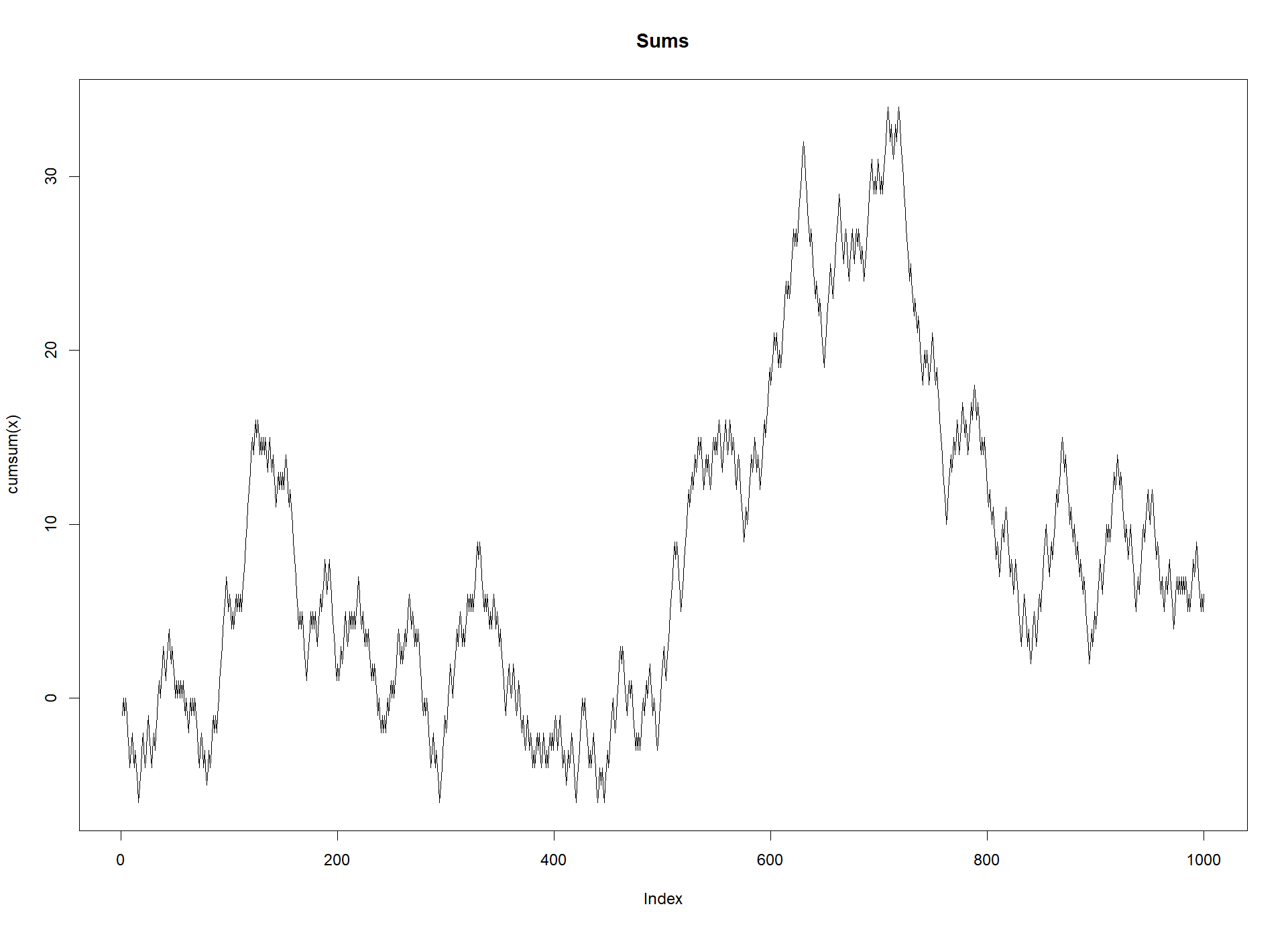
23. 判断数据框的列是否为数字?
sapply(dataframe, is.numeric)
24.如何将数据标准化?
使用scale函数。
x <- c(rnorm(100), 2 * rnorm(30))
m <- scale(x, scale = F)
n <- scale(x, center = F)
25.如何获取分位数?
x <- c (1 , 4 , 6 , 17 , 50 , 51 , 70 , 100)
quantile(x)
# 0% 25% 50% 75% 100%
# 1.00 5.50 33.50 55.75 100.00
26.如何生成对角矩阵?
对一个向量使用 diag() 函数,得到对角线元素为向量的对角矩阵.
diag(3)
# [,1] [,2] [,3]
# [1,] 1 0 0
# [2,] 0 1 0
# [3,] 0 0 1
27. 如何构造上(下)三角矩阵?
使用lower.tri() 和 upper.tri()函数。
# 下三角矩阵
Rmat <- matrix(1:16, 4:4)
Rmat[upper.tri(Rmat)] <- 0
Rmat
# [,1] [,2] [,3] [,4]
# [1,] 1 0 0 0
# [2,] 2 6 0 0
# [3,] 3 7 11 0
# [4,] 4 8 12 16# 上三角矩阵
Rmat <- matrix(1:16, 4:4)
Rmat[lower.tri(Rmat)] <- 0
Rmat
# [,1] [,2] [,3] [,4]
# [1,] 1 5 9 13
# [2,] 0 6 10 14
# [3,] 0 0 11 15
# [4,] 0 0 0 16
28. 如何求矩阵各行 (列) 的均值?
使用 apply() 函数或colMeans() 函数。
n <- 5
m <- 4
# 构造5行,4列矩阵
mat <- matrix(1:m*n, m, n)
mat
# [,1] [,2] [,3] [,4] [,5]
# [1,] 5 5 5 5 5
# [2,] 10 10 10 10 10
# [3,] 15 15 15 15 15
# [4,] 20 20 20 20 20mat_mean <- matrix(apply(mat, 2, mean), m, n, by=T)
# 或 mat_mean <- matrix(colMeans(mat), m, n, by=T)mat_mean
# [,1] [,2] [,3] [,4] [,5]
# [1,] 12.5 12.5 12.5 12.5 12.5
# [2,] 12.5 12.5 12.5 12.5 12.5
# [3,] 12.5 12.5 12.5 12.5 12.5
# [4,] 12.5 12.5 12.5 12.5 12.5
29 如何求一元方程的根?
使用uniroot()函数,该函数基于二分法计算方程根,初始区间不满足求根条件,则会报错。
f <- function(x)x^3 - 2*x -1
uniroot(f, c(0,2))
# $root
# [1] 1.618018
#
# $f.root
# [1] -9.17404e-05
#
# $iter
# [1] 6
#
# $init.it
# [1] NA
#
# $estim.prec
# [1] 6.103516e-05
30. 如何在 R 里面求(偏)导数?
使用函数D()
f1 <- expression(sin(x)*x)
D(f1,"x")
# cos(x) * x + sin(x)f2 <- expression(x^2*y + y^2)
D(f2,"y")
# x^2 + 2 * y
31. 如何在 R 中计算高斯(正态)分布的概率计算?
如已知 X˜N(3, 1),计算P(2 ≤ X ≤ 5)。
# 利用正态分布的累积分布函数 pnorm
pnorm (5 ,3 , 1 ) − pnorm (2 ,3 ,1 )
# 计算结果为 0.8185946,即下图中阴影的面积。
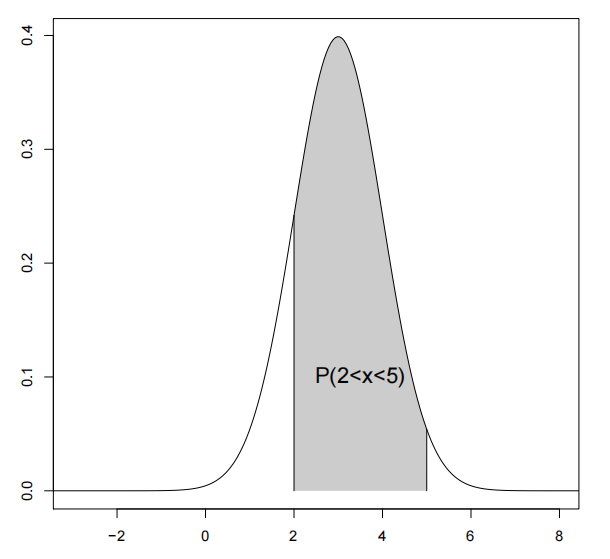
32. R如何在保存文件时用变量替换文件名内容?
使用 paste() 函数。
save_string = "test"
for(var in range(1,3)){# paste("File_", var, ".txt", sep = "")为组合的文件名write.table(save_string , paste("File_", var, ".txt", sep = ""))
}
33. 如何在R中使用正则表达式?
使用 grep() 函数。
index <- grep("J.", month.abb)
# [1] 1 6 7
month.abb[index]
# [1] "Jan" "Jun" "Jul"
34. R语言如何截取字符串?
使用 substr() 函数。
str <- "abcdefg"
substr(str, 2, 4)
# [1] "bcd"
substring(str, 1:6, 1:3)
# [1] "a" "b" "c" "" "" ""
35. R语言如何对日期进行算术运算?
使用 difftime(arg) 函数, arg支持“auto”, “secs”, “mins”, “hours”, “days”, “weeks”参数。
d1 <- c("24/02/01")
d2 <- c("24/03/01")D1 <-as.Date(d1, "%y/%m/%d")
D2 <-as.Date(d2, "%y/%m/%d")difftime(D2, D1, units = "days")
# Time difference of 29 daysdifftime(D2, D1, units = "weeks")
# Time difference of 4.142857 weeks
36. R语言如何对系统时间进行格式化输出?
使用 format() 函数。
format((Sys.Date()), format="%A, %d %B %Y")
37. R语言如何在同一画面画出多张图?
推荐使用 layout() 函数。
layout(matrix(c(1, 1, 1,2, 3, 4), nr=2, byrow=T))
hist(rnorm(10, 0, 1), col = "VioletRed")
hist(rnorm(10, 0, 1), col = "VioletRed")
hist(rnorm(10, 0, 1), col = "VioletRed")
hist(rnorm(10, 0, 1), col = "VioletRed")
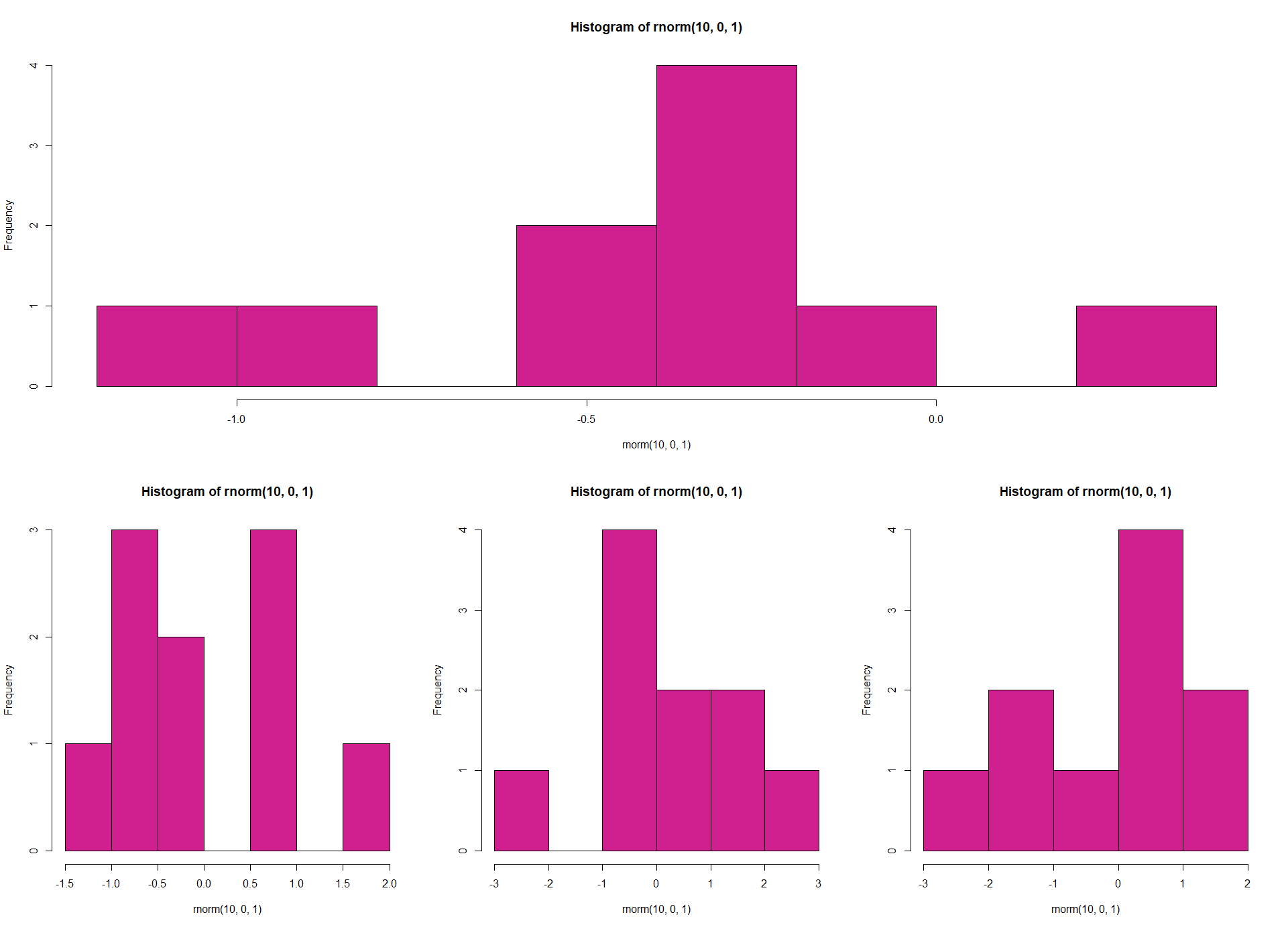
38. R语言如何设置图形边缘大小?
修改绘图参数 par(mar = c(bottom, left, top, right))
# 默认矩阵
par(mar = c(5, 4, 4, 2) + 0.1)
39. R语言 常用的 pch 符号都有哪些?
pch 是 plotting character 的缩写。pch 符号可以使用 “0 : 25” 来表示 26 个标识(参
看右图 “pch 符号”)。当然符号也可以使用#, %, ∗, |, +, −, ., o, O。值得注意的是,21 : 25
这几个符号可以在 points 函数使用不同的颜色填充(bg= 参数)。
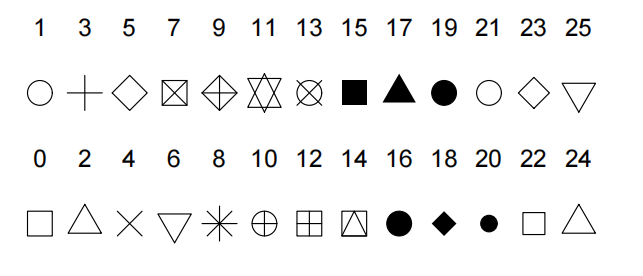
op <- par(bg = "light blue")
x <- seq(0, 2*pi, len=51)plot(x, sin(x), type="o", bg=par("bg"))
points(x, sin(x), pch=21, cex=1.5, bg="red")

40. R语言如何给图形加上图例?
绘制图形后,使用 legend函数。
# 查看自带isis数据集
head(iris)
# Sepal.Length Sepal.Width Petal.Length Petal.Width Species
# 1 5.1 3.5 1.4 0.2 setosa
# 2 4.9 3.0 1.4 0.2 setosa
# 3 4.7 3.2 1.3 0.2 setosa
# 4 4.6 3.1 1.5 0.2 setosa
# 5 5.0 3.6 1.4 0.2 setosa
# 6 5.4 3.9 1.7 0.4 setosa
with(iris, plot(Sepal.Length, Sepal.Width, pch=as.numeric(Species), cex=1.2))table(iris$Species)
# setosa versicolor virginica
# 50 50 50 legend(6.1, 4.1, c("setosa", "versicolor", "virginica"),cex=1.5, pch=1:3)
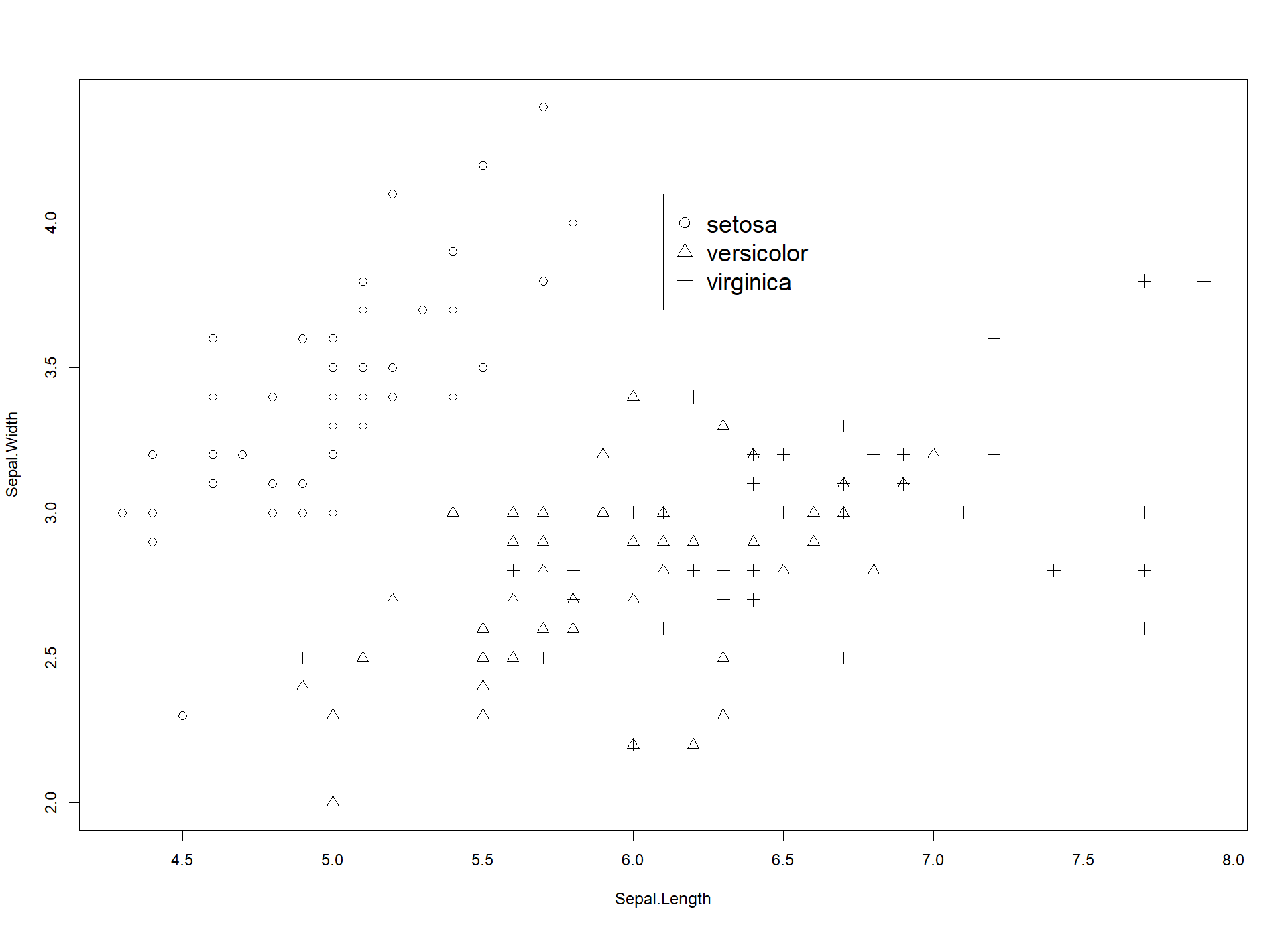


 函数的使用)

>)


)





)
)
)
)


